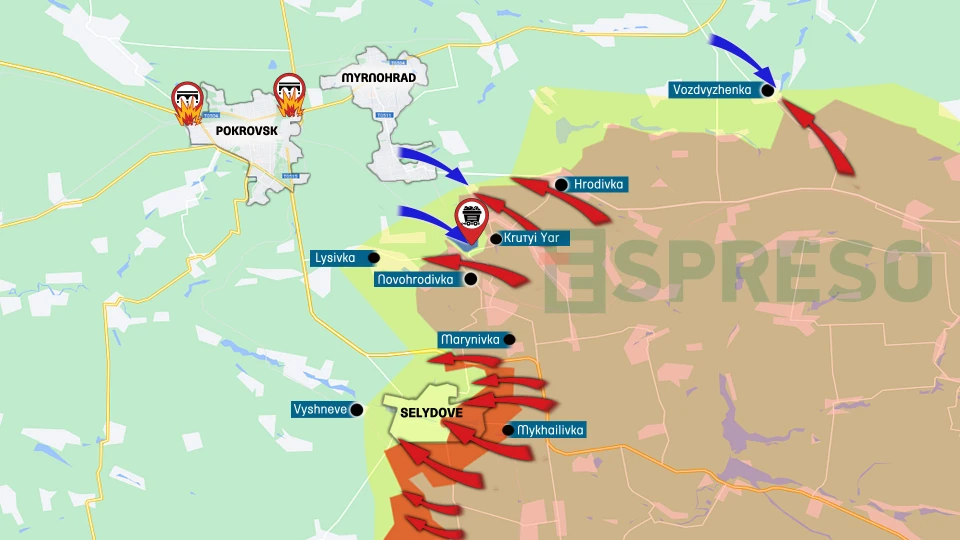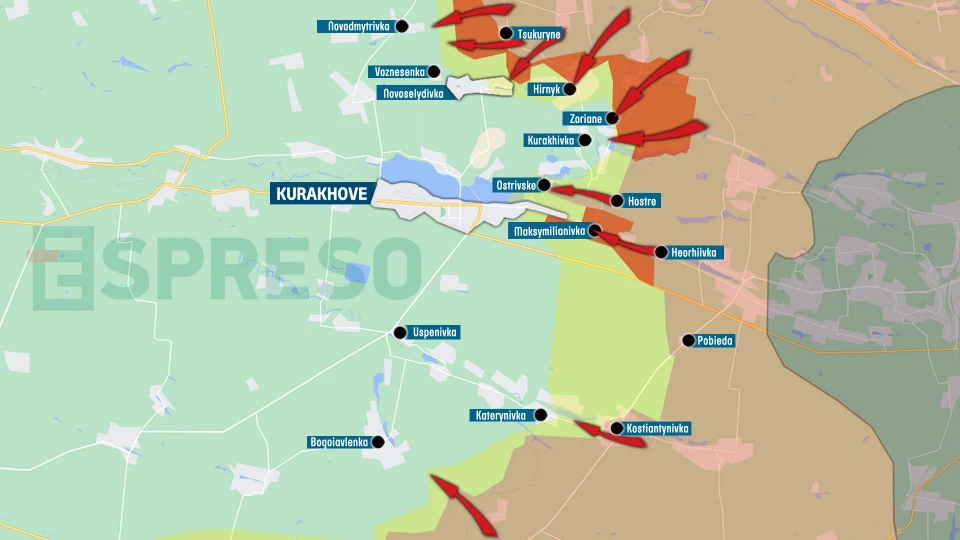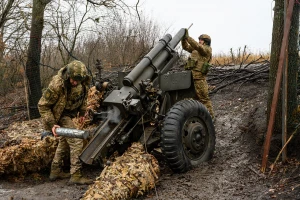
Civilian shootings reported in Selydove following Russian capture. Serhiy Zgurets' column
Russian forces now have near-total control over the settlement of Selydove. Reports have emerged of civilian shootings in areas where Russian troops have entered
Frontline situation
So, where should our focus be on the frontlines? Naturally, it’s on the military actions around Pokrovsk and Kurakhove, where Russian troops are combining operations with a theoretical strategy, along with attacks in southern Donbas — but more on those later.
In the Pokrovsk sector, the Russian offensive has been ongoing for a year, beginning with the push on Avdiivka last October. This area now holds the highest concentration of Russian forces compared to other sectors, with around 120,000 troops out of the larger Russian contingent of over 600,000. There are over a thousand artillery units, including both rocket and barrel artillery, making this the largest artillery buildup across the front.

Of course, Russia's losses here are also the heaviest. We don’t have exact numbers, but it’s known that last month saw record losses of 38,000 personnel. Most of these casualties are likely from the Pokrovsk and Kurakhove sectors. Additionally, Russia's armored losses are substantial, with 539 tanks and 1,830 various vehicles destroyed in the Pokrovsk area over the past year.
Despite these setbacks, Russian forces are advancing. In recent days, they have made progress in Selydove, gaining near-total control. If Ukrainian units remain, they’re likely positioned in the northwestern part of the settlement. In areas now occupied by Russian forces, there have been reports of civilian shootings, which we’ve confirmed with evidence. Ukraine's 15th Kara-Dag Brigade, which defended Selydove, was seen helping civilians who had not yet evacuated.
Currently, the Ukrainian brigade has left Selydove. The Kara-Dag Brigade withdrew through Vyshneve, a northern settlement through which key transport and supply lines pass. While Russian troops control Vyshneve, there’s still a potential route for movement from another area around Selydove. The situation remains extremely tense.
It’s expected that Russian forces from Selydove may attempt to launch further attacks toward Kurakhove if they find the opportunity. Another axis, now forming in Kurakhove, comes from the south. Last weekend, Russian troops struck several southern Donbas settlements, including Shakhtarske, Bohoyavlenka, and Ukrainske — three villages in southern Donetsk. These areas were relatively calm until the recent capture of Vuhledar, which shifted the situation, leading to intensified attacks on Shakhtarske, Ukrainske, and Bohoyavlenka.
The 128th Mountain Assault Brigade pushed back Russian advances in this direction, though Russians have made gains in Shakhtarske. This suggests they may be setting up for a possible assault on Kurakhove from the south. These dual offensives could allow Russians to avoid a direct assault on Kurakhove itself, given the water barriers and industrial zones there, which complicate advances from the east.

However, all of these are just theoretical predictions of potential Russian actions. Forecasting in wartime is nearly impossible, as each day can bring unforeseen developments. For now, it’s clear that Russia holds some initiative in specific areas. The primary task for Ukraine's military leaders is finding effective ways to counter these offensive actions.
On Ukrainian drone operations
Vyacheslav, commander of the unmanned attack drone company in the 68th Separate Hunting Brigade "Shershni Dovbusha," reports that the situation in the Pokrovsk direction remains tough and unchanged. Russian forces continue advancing despite heavy losses in manpower and equipment. Recently, Ukrainian units have held their positions firmly, but Russian offensives remain relentless. In a single day, the "Shershni Dovbusha" brigade took out 132 invading Russian soldiers, and about 600 in a week. During the defense of Kharkiv, drone operators handled around 10 FPV drone sorties per day; now, that number has surged to 50 — a fivefold increase in combat intensity.
Vyacheslav notes that drone pilots are exhausted, working around the clock. It's tough work, though they do rest after shifts. Engineers, FPV techs, and sappers prepping munitions — all are on a 24/7 cycle. The team constantly innovates; there’s no “standard” drone here. Every flight demands adjustments to ensure stable connections and clear video feed. Russian electronic warfare is constantly jamming them, but the crew always finds ways to adapt.
He also highlighted Viktor Stelmakh, call sign "Saba," one of the brigade's best pilots and a founding member. Viktor was a powerhouse, with nearly 1,000 confirmed hits on enemy forces, and he trained many of the unit’s pilots. Few soldiers show such dedication and skill. A petition is circulating now to award Viktor the title of Hero of Ukraine in his memory, and all readers are encouraged to support it.
For those interested in joining the brigade as drone operators, Vyacheslav shared that contact information is available on social media. New recruits undergo both basic and specialized training. Many have joined the 68th UAV unit specifically and are already delivering solid results. Some were mobilized soldiers, like one guy who was brought in; now he's one of the top pilots, impressing both his comrades and the entire command with his skill in taking down the enemy. Most of the unit consists of fighters who have been here since the start of the full-scale invasion or from the ATO. Despite the exhaustion, they remain committed to the fight.
- News













































